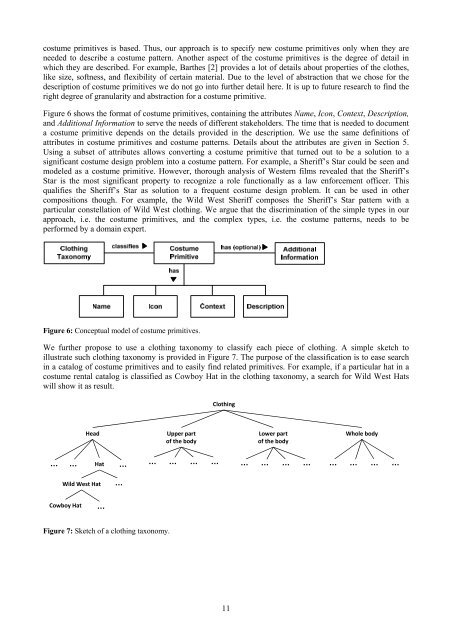A Pattern Language for Costumes in Films - IAAS
A Pattern Language for Costumes in Films - IAAS
A Pattern Language for Costumes in Films - IAAS
You also want an ePaper? Increase the reach of your titles
YUMPU automatically turns print PDFs into web optimized ePapers that Google loves.
costume primitives is based. Thus, our approach is to specify new costume primitives only when they are<br />
needed to describe a costume pattern. Another aspect of the costume primitives is the degree of detail <strong>in</strong><br />
which they are described. For example, Barthes [2] provides a lot of details about properties of the clothes,<br />
like size, softness, and flexibility of certa<strong>in</strong> material. Due to the level of abstraction that we chose <strong>for</strong> the<br />
description of costume primitives we do not go <strong>in</strong>to further detail here. It is up to future research to f<strong>in</strong>d the<br />
right degree of granularity and abstraction <strong>for</strong> a costume primitive.<br />
Figure 6 shows the <strong>for</strong>mat of costume primitives, conta<strong>in</strong><strong>in</strong>g the attributes Name, Icon, Context, Description,<br />
and Additional In<strong>for</strong>mation to serve the needs of different stakeholders. The time that is needed to document<br />
a costume primitive depends on the details provided <strong>in</strong> the description. We use the same def<strong>in</strong>itions of<br />
attributes <strong>in</strong> costume primitives and costume patterns. Details about the attributes are given <strong>in</strong> Section 5.<br />
Us<strong>in</strong>g a subset of attributes allows convert<strong>in</strong>g a costume primitive that turned out to be a solution to a<br />
significant costume design problem <strong>in</strong>to a costume pattern. For example, a Sheriff’s Star could be seen and<br />
modeled as a costume primitive. However, thorough analysis of Western films revealed that the Sheriff’s<br />
Star is the most significant property to recognize a role functionally as a law en<strong>for</strong>cement officer. This<br />
qualifies the Sheriff’s Star as solution to a frequent costume design problem. It can be used <strong>in</strong> other<br />
compositions though. For example, the Wild West Sheriff composes the Sheriff’s Star pattern with a<br />
particular constellation of Wild West cloth<strong>in</strong>g. We argue that the discrim<strong>in</strong>ation of the simple types <strong>in</strong> our<br />
approach, i.e. the costume primitives, and the complex types, i.e. the costume patterns, needs to be<br />
per<strong>for</strong>med by a doma<strong>in</strong> expert.<br />
Figure 6: Conceptual model of costume primitives.<br />
We further propose to use a cloth<strong>in</strong>g taxonomy to classify each piece of cloth<strong>in</strong>g. A simple sketch to<br />
illustrate such cloth<strong>in</strong>g taxonomy is provided <strong>in</strong> Figure 7. The purpose of the classification is to ease search<br />
<strong>in</strong> a catalog of costume primitives and to easily f<strong>in</strong>d related primitives. For example, if a particular hat <strong>in</strong> a<br />
costume rental catalog is classified as Cowboy Hat <strong>in</strong> the cloth<strong>in</strong>g taxonomy, a search <strong>for</strong> Wild West Hats<br />
will show it as result.<br />
Cloth<strong>in</strong>g<br />
Head<br />
Upper part<br />
of the body<br />
Lower part<br />
of the body<br />
Whole body<br />
… … Hat<br />
…<br />
… … … …<br />
… … … …<br />
… … … …<br />
Wild West Hat<br />
…<br />
Cowboy Hat<br />
…<br />
Figure 7: Sketch of a cloth<strong>in</strong>g taxonomy.<br />
11
















